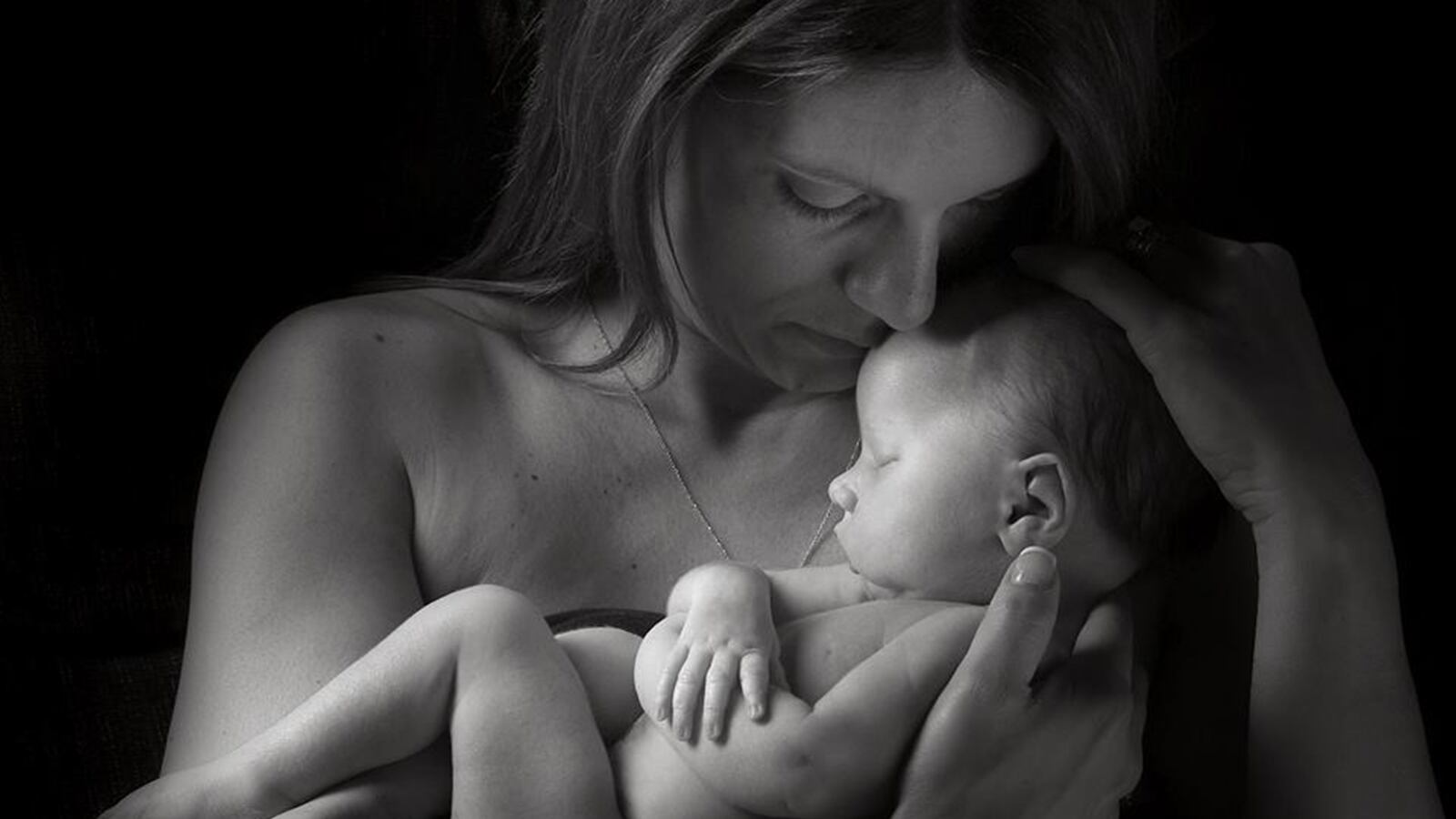In 2005, photographer Sandy Puc found herself in a Denver hospital taking portraits of a mother cradling a child that would be taken off life support after she finished the shoot.
“I almost didn’t want to stop shooting because I knew that, once I ended, this little boy would stop breathing,” Puc told The Daily Beast. “I looked at [the mother] and kind of nodded and said, ‘OK, I’m done.’ I remember her looking up at me. Both of us knew what that meant.”
A few days beforehand, Puc had no idea that she would be taking on this unusual assignment, nor that it would lead to the creation of the worldwide charity organization Now I Lay Me Down to Sleep, which now serves parents facing similar, tragic situations.
Cheryl and Mike Haggard first found Puc through her popular portraits of mothers and babies that were then hanging in several Denver-area hospitals. When their son Maddux was born with myotubular myopathy, a neuromuscular disorder that would prove fatal in his case, the Haggards wanted to remember his face. That’s when they called Puc’s studio with the unusual request to photograph their son both before and after his life support was terminated.
“I remember hearing that and being totally overwhelmed,” Puc said. “I don’t think I said anything, I think I just nodded that I would do it. I remember my head was going, ‘Oh, gosh, there’s no way,’ but my heart was bursting, ‘Of course, I’ll do it.’”
What followed, Puc says, can only be described as “surreal.” First, she photographed the family while Maddux was still on life support, carefully capturing every detail: fingers, toes, ears. And then, after life support was ended and the tubes were removed from Maddux’s body, she took more portraits—images just like the tender ones displayed in Denver hospitals except for the single and unimaginably heartbreaking detail that Maddux had passed away.
“Honestly, other than the discoloration, he looked just like a little sleeping baby,” Puc said.
But the experience was trying for both her and the grieving family. Cheryl Haggard was “calm” after Maddux died, Puc says, and “forcing herself to keep it together” so that she could create the memento. Puc, too, had to grapple with her own emotions in order to finish the assignment. Even now, her voice trembles as she recalls the story.
“It was definitely very emotional, yet the whole time I knew that if this little boy had to pass away, at least they would have these portraits,” she said.
Two months later, Puc and Haggard co-founded Now I Lay Me Down to Sleep (NILMDTS), a nonprofit organization that now connects parents who have lost a child with a network of over 1,700 volunteer photographers in the U.S. and other countries. Through the NILMDTS website, parents can request photographers to come to a hospital or hospice location on short notice to take free professional portraits.
Remembrance photography, as NILMDTS calls it, is new and old at once. Puc told The Daily Beast that, when she co-founded the organization in 2005, she knew of only one other photographer in the world who offered a similar service, and he was charging for it. In the Victorian era, however, post-mortem photography of children and infants was commonplace and served a similar memorializing function. In the intervening century and change, Western attitudes toward death shifted and the infant mortality rate dropped dramatically.
But every year, tens of thousands of women in the U.S. still experience the loss of a baby.
According to CDC statistics, approximately 24,000 babies are stillborn in the U.S. annually. Another 3,500 suffer sudden unexpected infant deaths (SUID). Others are born dangerously premature or suffer from fatal birth defects. Together, the U.S. has an infant mortality rate of 6.1 infant deaths per 1,000 live births, higher than most European countries. In 2013, that amounted to 23,000 infants dying within the first year of life.
Behind these numbers, NILMDTS CEO Gina Harris says, are women who are often grieving in silence.
“Infant loss is a taboo subject,” she told The Daily Beast. “You don’t think about it happening until it happens to you or someone close to you.”
Before she became CEO in 2011, Harris met Puc in 2007 after she requested a photographer through NILMDTS who could take portraits of her and her husband with their stillborn son David. A year later, she suffered another stillbirth and opted not to take photos due to the severity of the child’s condition.
“I regret not at least getting pictures of his hands and feet,” Harris said. “I regret not having a picture of him maybe wrapped in a blanket with my husband and I holding him. What it is, is proof of existence. It’s proof my babies existed.”
Puc adds that she now routinely meets parents who wish that they had remembrance photographs of a lost child.
“For most people who lose a baby, it happens so quick that they have virtually no time with that child, and they have no recollection over time of what the child looked like,” she said. “I think it’s terrifying for a mom to realize that she forgot her baby’s face.”
But what Puc and Harris see as a way to help grieving mothers, others have labeled as morbid. In 2011, when the Duggars released NILMDTS-coordinated photos of their stillborn daughter, some criticized the family’s public airing of grief. Others questioned the photography itself.
Social psychologist Susan Newman told The Daily Beast, “From what I know of parents who have lost children, it’s horrific. It’s not something you want pictures of.”
At the time, NILMDTS co-founder Cheryl Haggard defended the Duggars, telling The Daily Beast, “Unless you’ve walked in a bereaved parent’s shoes, you have no idea what you would need or what you would want or what could help you.”
But the practice of memorializing stillborn children is by no means restricted to the Duggars. As The Daily Beast’s Brandy Zadrozny reported in 2013, parents have been creating YouTube memorials for their stillborn children in increasing numbers. These videos receive negative comments, of course, but they also act as digital gathering sites for grieving parents.
Puc and Harris are both familiar with the criticisms of remembrance photography and have become seasoned in responding to them.
“When we first started this, within the first year, I heard the word ‘morbid’ more times than I had ever heard it in my whole life,” Puc told The Daily Beast.
Neither Puc nor Harris denies that the practice might seem inappropriate or unusual—at least, at first. In fact, when Harris learned about NILMDTS before her first stillbirth, she herself was wary of ever requesting the organization’s services.
“My initial thought was: Is that appropriate? Should I do that?” Harris said. “But then when I went to the website, and I looked at the beautiful images, I realized that I would never have that moment again and I knew I wanted photographs even if I never looked at them.”
“[I]t is a very strange practice,” Puc admitted. “But to someone who understands it, it is life-changing.”
Both the co-founder and the CEO respect differences of opinion on their work but argue that it is finally turning a corner toward mainstream acceptance. What started with a single photo shoot has grown over the last decade into a large nonprofit that coordinates directly with hospitals and has volunteer teams in seven countries.
“I’ve been with this organization for four years now and I’m hearing that [‘morbid’] comment less and less,” Harris said.
“What’s been very interesting to me is to watch an entire global change where people now understand the value and they see that what we’re doing is really beautiful for these families,” added Puc.
But along with that expansion have come challenges in the form of unmet demand and concerns about potential photographer burnout. Puc notes that the experience can be draining for the organization’s photographers, some of whom do shoots multiple times per week.
“Even though we have many photographers, we still do not have enough,” Harris said. “We are declining sessions daily.”
“Every photographer that does it, every single one of them, will tell you, it is the most beautiful thing they’ve ever done,” said Puc. “It may be the hardest, but it’s the most beautiful.”





